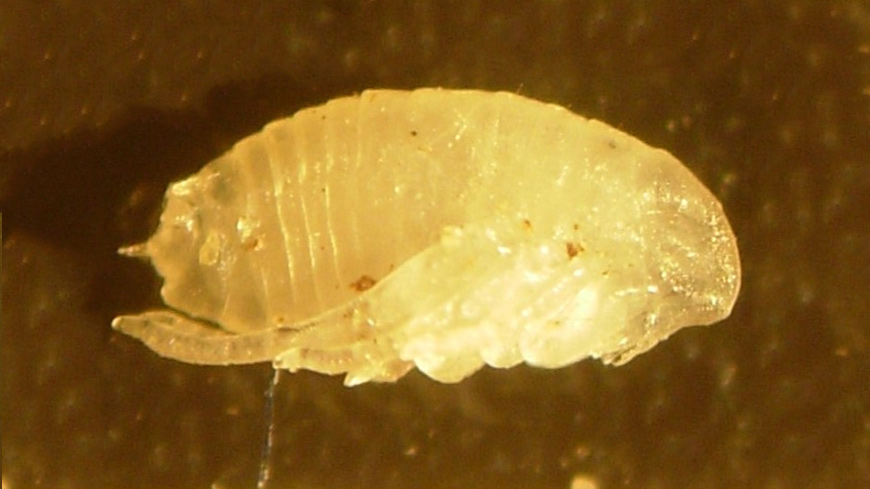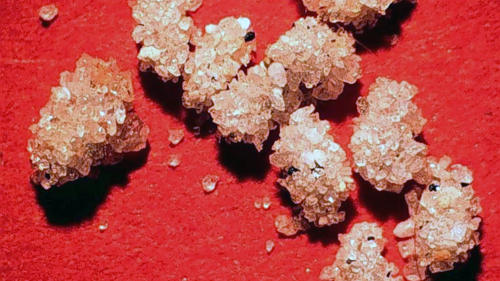
Img 1 Cat flea pupa without a cocoon (naked pupa).
Summary
Naked pupae are pupae which develop without a cocoon. The cocoon isn’t necessary for survival and metamorphosis. Naked pupae develop when larvae can’t find a vertical surface to attach silk threads to. And, when newly formed cocoons are shaken, it forces larvae to abandon the structures.
Details
What are Naked Pupae?
Most fleas pupate inside of a cocoon Img 2. However, some develop without cocoons and are called naked pupae.

Img 2 Cat flea pupae within cocoons.
Naked Pupae vs Cocooned Pupae
Development & Survival
The cocoon isn’t necessary for survival and development. In optimal conditions, naked pupae survive and complete their metamorphosis just as well as cocooned pupae. 96.5% of naked pupae will successfully reach adulthood.
Quiescence & Emergence
The primary advantage of cocoons is that adults can enter into a quiescent state, where they can survive for up to 5 months. Naked pupae can’t enter into this dormant-like state. Without cocoons, the adults emerge from their pupal casing soon after reaching maturity.
Pre-emerged adults will quickly wake up and emerge from their cocoons upon sensing a nearby host. The two triggers are heat and physical pressure. Cocoons help prevent fleas from detecting non-host stimuli, thus minimizing their odds of emerging without a host around. Naked pupae don’t have this stimuli protection. They’ll emerge readily, even in the absence of a host.
Vacuum Removal
When vacuuming, naked pupae are easier to remove from carpets than those enclosed in a cocoon. This is because cocoon threads get spun into the carpet fibers, making them adhere tightly.
Protection from Predators
Pupae are the most hardy life stage. How much of this resilience is due to the cocoon is unknown. However, the silk structure does protect pupae from potential predators, such as ants and cannibalizing flea larvae.
What Causes Naked Pupae?
Inhibiting Cocoon Formation
Less than 3% of flea larvae are able to spin cocoons without a vertical surface to align themselves with. Larvae raised in flat-bottom containers can only form cocoons against the container’s walls. In round-bottom containers, the larvae fail to form cocoons. Silk is deposited randomly across the containers bottom. When glass beads are added to the containers, the larvae can vertically orient themselves, and there’s an increase in successful cocoon formation. The larger the beads, the more successful the cocoon formation Fig 1.
Fig 1 Percentage of larvae which complete cocoons (y-axis) in a round-bottom container with different sizes of beads (x-axis).
Forcing Cocoon Abandonment
Shaking & Agitation
Flea larvae being pupating 18 hours after completing their cocoon. If disturbed prior to this, through shaking, agitation, or direct pressure, they may abandon their cocoons. Abandonment can occur during cocoon formation, or after the structure is complete.
If cocoons less than 12 hours old are gently shifted, then 13.7% the larvae will emerge. If vigorously shaken, 26.7% will emerge. If shaken again, another 2.2% abandoned their cocoons. All in all, 42.6% of the larvae left their cocoons after gentle sifting and agitation.
In carpeted home environments, it may be possible to force naked pupae to develop by vacuuming. Beater-bar vacuum cleaners cause vigorous agitation to carpet fibers, which could cause flea larvae to abandon their cocoons.
Spinning a Second Cocoon
After abandoning their cocoons, 49.1% of larvae will spin a second cocoon, 42.9% develop as naked pupae, and 8.0% die. Larvae forced to construct a second cocoon become lighter pupae and adults. And they’ll emerge significantly sooner than those that only spun a single cocoon, most likely as a result of depleted energy reserves. Similar results occur when larvae are undernourished.




You must log in to post a comment. Log in now.